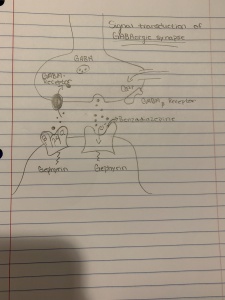
Sleep
When sitting in class and finishing work many individuals look forward to a specific time of the day. This is the time in which we can snuggle into our beds and fall asleep. However, is sleep more important than we think? Sleep provides healing and restoration and promotes good health and recovery from illness. Sleep is a cyclical physiological process that alternates with long periods of wakefulness. It influences physiological function and behavioral responses. This is controlled by your internal clock called your circadian rhythm. The part of your brain that controls the circadian rhythm is the suprachiasmatic nucleus (SCN) nerve cells in the hypothalamus control the rhythm of the sleep-wake cycle and coordinate this cycle with other rhythms.
Sleep Disturbance
There are some symptoms of the sleep cycle that cause disturbances and result in lack of sleep. These include anxiety, restlessness, irritability, and impaired judgement. However, is lack of sleep really that big of a problem? Lack of sleep can have serious potential problems for one’s health including high blood pressure, diabetes, heart attacks, and heart failure. The previous list of health problems relates to that of physical health, but what about the physiological perspective of the brain? When making memories it is important to note that there are three types of ways in which something can become a memory. This includes acquisition-learning or experiencing something new, recall-having the ability to access the memory in the future, and consolidation-the memory becomes stable in the brain. The first two are through to be done while an individual is awake, however, consolidation requires an individual to be asleep. This is because adequate sleep aids in the health of your hippocamps and neocortex within the brain. These areas while sleeping are believed to replay the events of the day and review/process memories and move them into an area where they can be stored as long-term memories.
Are there medical ways to help insomnia?
GABA are inhibitory neurotransmitters of the central nervous system that aids in sleep. GABA inhibitors are broken down into three different generations of hypnotics based on the GABA receptor mediated inhibitory process. These include the first- and second-generation hypnotics being barbiturates and benzodiazepines, while the third generation of hypnotics being imidazopyridines and cyclopyrrolones. The first- and second-generation hypnotics decrease waking, increase slow-wave sleep and enhance paradoxical sleep. Slow-wave sleep is the third phase of sleep which is the deepest phase of non-rapid eye movement sleep. During this time dreaming and sleepwalking can occur. This stage is also important for memory consolidation, which is a process where recently learned experiences are transformed into long-term memory. When paradoxical sleep is reached intense brain activity in the forebrain and midbrain occur. It differs from slow wave sleep due to the absence of motor function except for eye muscles and the diaphragm. An individual is unable to sleepwalk but is still dreaming during this time. The third generation of hypnotics is like that of the first- and second-generation hypnotics on waking and slow wave sleep but has a decreased paradoxical sleep during the first few hours of sleep.
How do benzodiazepines work?
 By Hannah P.
By Hannah P.
Benzodiazepines are a class of drugs named for their chemical structure that are commonly used to treat anxiety disorders and sleep-related disorders. They include well-known drugs like valium, Xanax, and klonopin. There are dozens of drugs in the benzodiazepine class, but the mechanism by which they all exert their effects is thought to be similar. The sedating and anxiety-reducing effects of benzodiazepines are believed to be attributable to the drugs’ actions at receptors for the neurotransmitter gamma-aminobutyric acid (GABA). In particular, benzodiazepines act at a subtype of GABA receptors called the GABAa receptor; GABAa receptors that also bind benzodiazepines are sometimes called benzodiazepine receptors. When benzodiazepines bind, or attach, to the GABA receptor, they bind at alocation separate from where GABA itself binds and exerts an influence over GABA binding. This type of action is called an allosteric effect, and in the case of benzodiazepines it results in increased action at the GABA receptor. There is not complete consensus on exactly how benzodiazepine binding affects activity at the GABA receptor but there is evidence to suggest that it increases the likelihood that GABA binding will activate the receptor and/or increases the effect that GABA has when it binds to the receptor. That effect is to open an ion channel and allow the passage of negatively charged chloride ions into the neuron. This influx of negatively charged ions pushes the membrane potential further from zero, or hyper polarizes it, and makes it less likely the neuron will fire an action potential.This type of neural inhibition is the basis for the effects of benzodiazepines, for by inhibiting the activity of neurons that make up networks involved with anxiety and arousal, the drugs are able to produce calming effects.